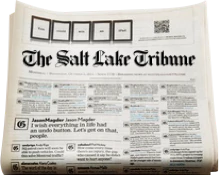This is an archived article that was published on sltrib.com in 2004, and information in the article may be outdated. It is provided only for personal research purposes and may not be reprinted.
Native fish have been missing their spawning cues and pools for so many years along the Green River that four species are now endangered.
Last week, the Bureau of Reclamation released a proposal to address the problem, essentially by modifying the water flows and temperatures at Flaming Gorge Dam to more closely mimic seasonal water conditions that existed downstream before the dam was built in the 1960s.
By doing so, bureau environmental specialist Beverly Heffernan says the razorback sucker, humpback chub, Colorado pikeminnow and bonytail can be revived - both through higher spring flows that will signal the spawning season and the creation of sand bars and side channels where eggs will be better protected from predators.
"What we're trying to do is provide a more natural flow to the river while continuing to meet our obligations to provide a storage reservoir and hydroelectric power under the Colorado River Storage Act," said Heffernan, who is based in the bureau's Provo office.
But the draft environmental impact statement - now in the public comment period - has been panned by environmentalists. Fishing guides who operate in the trout-rich waters below the dam also have expressed concerns.
For John Weisheit, conservation director of Moab-based Living Rivers, the issue is one of shortsightedness. Contending that this same proposal has failed elsewhere, he calls for a whole new assessment of the Colorado River system - of which the Green is a main tributary.
"The needs of the fish, the environment, the national parks were never addressed when decisions were made about how to allocate water from the Colorado River and its main tributaries, so we have these big problems now," said Weisheit. "The problem with this is, it doesn't work. They tried experimental flows in the Grand Canyon and at Glen Canyon Dam, and there is no record of success."
Weisheit says what's needed is "a big picture" review of the Colorado system, which he predicts will eventually result in the dismantling of dams such as Flaming Gorge and Glen Canyon because of decades-long sediment buildup in the reservoirs.
Heffernan says that issue is beyond the scope of her agency's charge.
"Decommissioning is not an option," she said. "The question isn't a matter of doing everything you can to save all of the fish; it's helping the fish survive under the mission we are given. What this [environmental statement] tells us is that we can achieve the flows and temperatures recommended without harming any of the other resources or purposes of the dam."
Among the resources below the dam is one of the nation's most acclaimed trout fishing areas. And at least one outfitter has conflicting emotions about the bureau's proposal.
"It all depends on how radically they alter the stream flows," said Dennis Breer, who owns a fly fishing guide service in Dutch John. "I've been involved with this process since 1990, when they began experimenting with the flows, and we saw some strange things happen. We've also seen in some cases that what's good for the native species is also good for the trout. But every time they move [the water flow] up and down it impacts the trout. So what we're concerned about is the extremes."
Heffernan says those concerns will be addressed.
"Under some circumstances the water could be too warm for the trout," she said. "We're working with [the Utah Division of Wildlife Resources] to further analyze these areas."
Flaming Gorge public hearings
All meetings begin at 6 p.m.
Oct. 12: Moab, Ramada Inn, 182 S. Main St.
Oct. 13: Salt Lake City, Downtown Marriott, 75 S. West Temple
Oct. 19: Rock Springs, Wyo., Holiday Inn, 1675 Sunset Drive
Oct. 20: Dutch John, Conference Hall, South Boulevard
Oct. 21: Vernal, Western Park Convention Center, 300 East and 200 South

